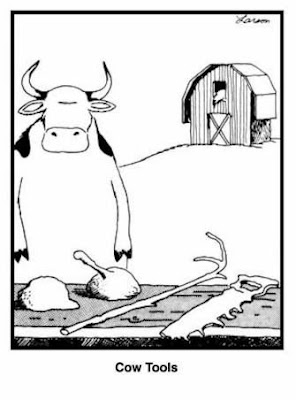It’s probably hard for people who grew up with pervasive Internet to
understand that newspaper comics were important cultural touchstones for
decades. In the 1980s and 1990s, one of the most successful was The Far Side, created by Gary Larson.
Academics got Gary Larson.
I lost count of how many Far Side cartoons I saw taped up on university doors and included in presentations. I once heard a presenter jokingly call him, “the official cartoonist of the Animal Behavior Society” (at the annual conference of the society, naturally).
But I suspect even academics went “Huh?” when newspapers ran, “Cow tools.”
People did not get it.
They did not get it so much that this single cartoon now has its own Wikipedia page. Larson is lucky that this was published pre-Internet. He only had to deal with phone calls and not angry emails and Twitter notifications. If it was published today, it would have gone viral, been ratioed on Twitter, and been denounced by pundits on political panel shows.
(O)ne day I started thinking about an anthropology course I had in college and how we learned that man used to be defined as “the only animal that made and shaped tools.” Unfortunately, researchers discovered that certain primates and even some bird species did the same thing – so the definition had to be expanded somewhat to avoid awkward situations such as someone hiring a crew of chimpanzees to remodel their kitchen.
Inevitably, I began thinking about cows, and what if they, too, were discovered as toolmakers. What would they make? ... The “cow tools”were supposed to be just meaningless artifacts – only the cow or a cowthropologist is is supposed to know what they’re used for.
Larson was so far down the rabbit hole of his thought process that he lost the ability to judge his own work.
This is a state that I know very well. Something about a project that I have been living with in my head for months or years that I might think is obvious is far from obvious to other people. It might not even be sensible to other people.
So to return to the question posed in the title of this post.
How is a conference poster like a joke?
If you have to explain it, you’ve failed.
As “Cow tools” shows, it’s easy for you to get in your own head and create something that makes perfect sense to you, but not to others.
If you have to explain something on a poster, you’ve failed.
Sticking with comics, here’s another example of the principle, this time more visual than conceptual:
The reading order of the page is confusing, and the artist knows it. The artist has to explain the reading order using arrows.
If you have to explain it, you’ve failed.
External linksHow to read Nancy review (features Batman page)







No comments:
Post a Comment